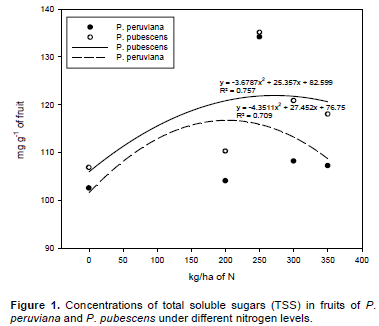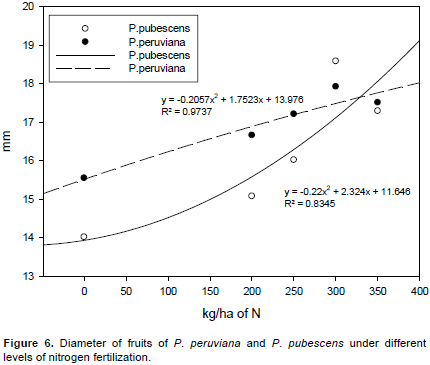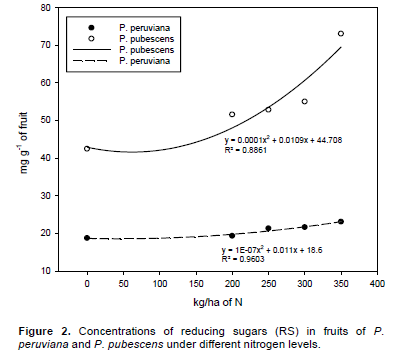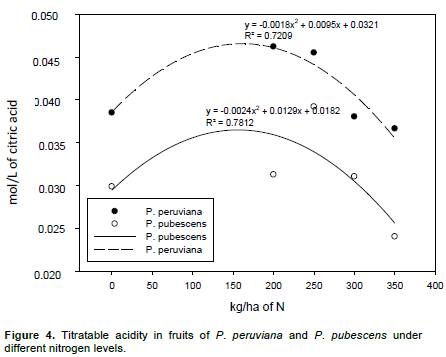ABSTRACT
Although small fruits, with some exceptions, are not yet as popular in Brazil, some farmers have invested in this market and the genus Physalis can be an important alternative source of income due to its high added value and possibility of cultivation in small areas. To date, there are no specific fertilizer recommendations for even the most cultivated species (Physalis peruviana) and therefore the goal of this study was to evaluate the effects of nitrogen fertilization on quality of fruits of Physalis peruviana and Physalis pubescens. Plants were grown in 5 L pots containing soil and maintained in a controlled environment, in greenhouse. Treatments consisted of five N levels (kg ha-1): 0, 200, 250, 300 and 350, with seven replicates per treatment. Variables evaluated were total soluble sugars and reducing sugars, phenolics, pH, titratable acidity and fruit diameter. Nitrogen increased soluble sugars (350 kg ha-1) and reducing sugars (300 kg ha-1), mainly in P. pubescens. There was a slight increase of juice pH, but concentrations of total phenols and citric acid decreased with increasing levels of N. Fruit diameter of the two species of Physalis was increased by N fertilization, and the best N level was 300 kg ha-1.
Key words: Physalis peruviana, Physalis pubescens, reducing sugars, titratable acidity, total phenolics.
Physalis is a plant of the family Solanaceae and according to El Sheikha et al. (2010) there are about 453 species, 100 of which are well known, and Mexico is considered the center of diversity of the genus (Whitson, 2012). Several species have shown important biological activities that turn them potential sources of pharmacological products (Tomassini et al., 2000; Wu et al., 2005; Arun and Asha, 2007).
The fruit of Physalis is sweet and slightly acid, with high levels of vitamins A, C, phosphorus and iron, as well as flavonoids and phytosterols (Rufato et al., 2008). The production and quality of the fruit depends on the balance of various natural and anthropomorphic environmental factors; among them, the soil fertility is the easiest to control and its proper management can result not only in increments of crop yield, but higher quality of the fruit (Valencia et al., 2003), through biochemical and physiological processes occurring in plants (Ferreira et al., 2006). Among them the photosynthetic activity and the rate of photosynthate translocation directly interferes with fruit quality, which can be understood as a set of different individual internal (color, odor, pH, soluble solids, etc.) and external characteristics (size, shape, color, etc.).
Nitrogen (N) has great effect on growth and absorption rates of other elements by the plant, and is one of the most important nutrients for plant nutrition. Nitrogen fertilization affects vegetative and reproductive characteristics of plants, enhances and increases the protein and nucleic acid synthesis, and promotes vegetative growth and the formation of floral and fruit buds. In Brazil, many crops are fertilized empirically, thus the experience of farmers prevails: But this may imply economic losses by a lack or excess of nutrients, which may result in changes in the characteristics of the fruit with decreased organoleptic quality.
Therefore, the objective of this study was to evaluate the effects of different levels of nitrogen on the chemical and physical characteristics of Physalis peruviana L. and Physalis pubescens L.
Seedlings of P. peruviana L. and P. pubescens L. were obtained by growing them in a greenhouse, from seeds of plants at Universidade Tecnológica Federal do Paraná, Brazil. The experiment was conducted from February to October, for two years (2011 and 2012), under 28 ± 2°C in the greenhouse. Seeds were placed on Styrofoam trays containing substrate (fertile humus), and three seeds were sown per cell, with thinning after 20 days, leaving one seedling per cell. When these were approximately 15 cm high (70 days old) they were transplanted to pots (5 L) containing soil as substrate, which was analyzed to perform fertilization (Table 1) with pH corrected to 5.8.

The experimental design was completely randomized with a factorial (2 × 5) arrangement of treatments: Species (P. peruviana L. and P. pubescens L.); and five N (as urea) levels (kg ha-1): 0, 200, 250, 300, 350; with 7 replications per treatment. The results were used for an ANOVA and treatment means were analyzed by orthogonal contrasts (p ≤ 0.05), using ASSISTAT software. Other two macronutrients (P and K) were maintained on fixed doses: 600 kg ha-1 P2O5 and 500 kg ha-1 KCl.
Due to the uneven ripening of the fruit, samples were taken weekly and analyses performed at Laboratory of Biochemistry and Plant Physiology of the UTFPR. Fruit were harvested when the calyx was yellow-greenish.
Fruit were weighed (Marte AY220 digital scalel) and then macerated by hand and filtrated. Variables evaluated were: pH (Tecnopon mPA-210 digital pH meter), titratable acidity (ascorbic acid); concentrations of total soluble sugars (TSS), using the methodology proposed by Dubois et al. (1956) and reducing sugars (RS), through the dinitrosalicylic acid (Miller, 1959) both by spectrophotometry (UV-1800 Shimadzu spectrophotometer UV-1800) with glucose as standard. Total phenolic compounds were determined by spectrophotometry using the methodology described by Makkar et al. (1993) with tyrosine as standard.
The different levels of nitrogen resulted in variations in the levels of metabolic compounds evaluated in both species of Physalis. With respect to the concentrations of soluble sugars, the fruits of both species showed increase with higher levels of nitrogen up to 300 kg ha-1 (Figure 1). In all levels of nitrogen tested, P. pubescens showed initial value of TSS greater than that of P. peruviana, responding better to the increments of the nutrient applied. Ferreira et al. (2006) suggest that increasing amounts of sugars until a given level of nitrogen are due to the biosynthesis of these compounds during photosynthesis, which are subsequently translocated to the fruit in the process of development and growth thereof. Bénard et al. (2009) reported higher concentrations of total sugars but at low nitrogen levels.

The reductions in TSS concentrations at levels above 300 kg ha-1 nitrogen may be the result of greater vegetative growth, which was observed in the experiment, in height and dry weight of shoots, besides the greater number of fruits, particularly in P. pubescens (data not shown).
Nitrogen stimulates the activation of meristematic tissues of the plant, leading to increased consumption of storage sugars (Nabinger, 1996; Alexandrino et al., 2004), thus in Physalis nitrogen fertilization above 300 kg ha-1 stimulates greater vegetative growth resulting in consumption of storage sugars to sustain this energy expenditure, hence reducing the levels to be translocated to the fruit.
This intense growth and subsequent translocation of sucrose for fruit and its inversion during maturation resulted in increases in the concentration of reducing sugars dependent on nitrogen levels in P. pubescens, with little variation in the levels of these compounds in P. peruviana (Figure 2). These responses confirm the ability of the first to respond differently to increasing levels of fertilization, possibly for being a more rustic species, not subjected to constant selection processes, even the most simple.
In tomato, Ferreira et al. (2006) found no change in total soluble solids, mainly represented by glucose and fructose, with increased level of N, which is also observed in P. peruviana, differently from P. pubescens and tomato in a study developed Valencia et al. (2003). In another experiment with tomato, reducing sugars were present at higher concentrations in reduced levels of N (Bénard et al., 2009).
The sugar content in fruit of Physalis, especially in P. pubescens, imparts a sweeter flavor to this species, which was confirmed by taste tests conducted with the community (data not shown).
In the analyses of total soluble phenolic compounds, the results were the opposite of primary compounds (sugars). From the dose of 200 kg ha-1 nitrogen in both Physalis species it was verified a cubic trend with increasing nitrogen levels. Between the two species, P. pubescens showed the highest values of phenols (Figure 3), similarly to that observed in tomato with higher concentrations of some phenolic compounds at lower nitrogen levels (Bénard et al., 2009).

The synthesis of phenolic compounds increases under stress, especially when the use of carbon for growth and/or reproduction decreases due to lack of nutrients (Kandil et al., 2004). When N limits growth of plants, there is an accumulation of carbohydrates in their tissues, according to the carbon/nutrient balance hypothesis (Bryant et al., 1983), thus this accumulation directs carbon to the synthesis of secondary metabolites (Hamilton et al., 2001), which seems to occur in Physalis. Coelho et al. (2012) also observed a decrease in the concentration of total phenolics with increasing level of N in leaves of potato plants, following a quadratic model.
The results are consistent with the inverse relationship between the synthesis of primary metabolites during the growth/development of plant and production of secondary metabolic compounds, including phenols. Thus, the phenol synthesis depends on the balance of sucrose and fruit are the preferred sinks, and therefore nutrients and carbohydrates are directed to their development as well as to other parts of the plant, rather than to synthesis and accumulation of phenolic compounds.
In relation to citric acid in Physalis fruit, it was observed that the concentrations showed a quadratic response with increases up to 200 kg ha-1 (Figure 4). P. peruviana showed the highest concentrations of citric acid, giving a more acidic flavor to fruit, when compared to P. pubescens, also confirmed by taste tests (data not shown).
Bénard et al. (2009) also obtained a reduced acidity with increasing nitrogen, resulting in less acidic characteristics to tomato fruit. Conversely, in muskmelon, there was an increase in the percentage of citric acid with higher N levels (Coelho et al., 2003). According to Blanco and Folegatti (2008) the citric acid content in tomato fruit increases with higher cation: Anion ratio in order to maintain electro neutrality in fruit tissues. As N is absorbed by plants preferentially in the form anion (NO3-), may have occurred an imbalance in this ratio, with increased N uptake in relation to other nutrients, such as K+ (Marshner, 1995).
These changes were also proved by direct measurement of pH (Figure 5), with elevation in values with increase of N for both species, but smallest variations in pH values were observed for P. pubescens. The increase in N levels may have increased fruit turgidity indirectly causing a drop in acidity values, due to the dilution of acids (Paula et al., 1991), which may have occurred in Physalis.
Similar results were verified by Silva et al. (2008), which registered that the increase in pH with increasing N levels is justified by the lower concentration of acids accumulated in guava fruit.
Fruit quality comprises chemical characteristics, size and number of fruit. In this way, we measured the diameters of the fruits of Physalis and as a result, the nitrogen positively affected this parameter up to the level of 300 kg ha-1, as shown in Figure 6. Fruit size was increased with fertilization, which was expected until reaching the threshold of nutritional need of the plant, from which the excess promoted no increased yield, which indicates that above the optimal value occur waste and losses, if the main goal is fruit production.

Increases in fruit diameter with increase in nitrogen fertilization were also reported by Coelho et al. (2003) and Queiroga et al. (2007), working with melon, by Pedrosa et al. (2012) with pumpkin, and by Brito Neto et al. (2011) with sunrise solo papaya, however with a decrease in size from a given level of nitrogen. According to these authors, the deficiency or excess of N affects the size and quality of the fruit, since high levels tend to increase the number rather than the size of the fruit, which seems to occur slightly in P. peruviana at a level of 350 kg ha-1.
In short, the results evidenced the positive effect of nitrogen in greenhouse cultivation for two species of Physalis. In general, 300 kg ha-1 can be considered the best level under the conditions of the experiment, which led to the set of positive characteristics that determine fruit quality, especially for P. pubescens.
The authors have not declared any conflict of interests.
To Fundação Araucária for financial support for conducting part of the experiments.
REFERENCES
|
Alexandrino E, Nascimento Jr D, Mosquim PR, Regazzi AJ, Rocha FC (2004). Características morfogênicas e estruturais na rebrotação da Brachiaria brizantha cv. Marandu submetida a três doses de nitrogênio. Rev. Bras. Zoot. 33(6):1372-1379.
Crossref
|
|
|
|
Arun M, Asha VV (2007). Preliminary studies on antihepatotoxic effect of Physalis peruviana Linn. (Solanaceae) against carbon tetrachloride induced acute liver injury in rats. J. Ethnopharmacol. 111(1):110-114.
Crossref
|
|
|
|
|
Bénard C, Gautier H, Bourgaud F, Grassely D, Navez B, Caris-Veyrat C, Weiss M, Génard M (2009). Effects of low nitrogen supply on tomato (Solanum lycopersicum) fruit yield and quality with special emphasis on sugars, acids, ascorbate, carotenoids, and phenolic compounds. J. Agric. Food Chem. 57(10):4112-4123.
Crossref
|
|
|
|
|
Blanco FF, Folegatti MV (2008). Doses de N e K no tomateiro sob estresse salino: III. Produção e qualidade de frutos. Rev. Bras. Eng. Agríc. Ambient 12(2):122-127.
Crossref
|
|
|
|
|
Brito Neto JF, Pereira WE, Cavalcanti LF, Araújo RC, Lacerda JS (2011). Produtividade e qualidade de frutos de mamoeiro "sunrise solo" em função de doses de nitrogênio e boro. Semina Ciênc. Agr. 32(1):69-80.
|
|
|
|
|
Bryant JP, Chapin FS, Klein DR (1983). Carbon/nutrient balance of boreal plants in relation to vertebrate herbivory. Oikos 40(3):357‑368.
Crossref
|
|
|
|
|
Coelho EL, Fontes PCR, Finger FL, Cardoso AA (2003). Qualidade do fruto de melão rendilhado em função de doses de nitrogênio. Bragantia 62(2):173-178.
Crossref
|
|
|
|
|
Coelho FS, Fontes PCR, Finger FL, Cecon PR (2012). Avaliação do estado nutricional do nitrogênio em batateira por meio de polifenóis e clorofila na folha. Pesq. Agropec. Bras. 47(4):584-592.
Crossref
|
|
|
|
|
Dubois M, Gilles KA, Hamilton JK, Rebers PA, Smith F (1956). Colorimetric method for determination of sugars and related substances. Anal. Chem. 28(3):350-356.
Crossref
|
|
|
|
|
El Sheikha AF, Piombo G, Goli T, Montet D (2010). Main composition of Physalis (Physalis pubescens L.) fruit juice from Egypt. Fruits 65(4):255-265.
Crossref
|
|
|
|
|
Ferreira MMM, Ferreira GB, Fontes PCR, Dantas JP (2006). Qualidade do tomate em função de doses de nitrogênio e da adubação orgânica em duas estações. Hortic. Bras. 24(2):141-145.
Crossref
|
|
|
|
|
Hamilton JG, Zangerl AR, Delucia EH, Berenbaum MR (2001). The carbon‑nutrient balance hypothesis: its rise and fall. Ecol. Lett. 4(1):86‑95.
Crossref
|
|
|
|
|
Kandil FE, Grace MH, Seigler DS, Cheeseman JM (2004). Polyphenolics in Rhizophora mangle L. leaves and their changes during leaf development and senescence. Trees 18 (5): 518‑528.
Crossref
|
|
|
|
|
Makkar HPS, Bluemmel M, Borowy NK, Becker K (1993). Gravimetric determination of tannins and their correlations with chemical and protein precipitation methods. J. Sci. Food Agr. 61(2):161-165.
Crossref
|
|
|
|
|
Marshner H (1995). Mineral nutrition of higher plants. 2. ed. London: Academic Press 889 p.
|
|
|
|
|
Miller GL (1959). Use of dinitrosalicylic acid reagent for determination of reducing sugar. Anal. Chem. 31(3):416-428.
Crossref
|
|
|
|
|
Nabinger C (1996). Princípios da exploração intensiva de pastagens. In: Peixoto, AM, Moura, JC, Faria, VP (eds.). Produção de bovinos a pasto. Piracicaba: Fundação de Estudos Agrários Luiz de Queiroz. pp. 15-95.
|
|
|
|
|
Paula MB, Carvalho VD, Nogueira FD, Souza LFS (1991). Efeito da calagem, potássio e nitrogênio na produção e qualidade do fruto do abacaxizeiro. Pesq. Agropec. Bras. 26(9):1337-1343.
|
|
|
|
|
Pedrosa MW, Mascarenhas MHT, Freire FM, Viana MC, Gonçalvez LD, Lara JFR, Ferreira PC (2012). Produção e qualidade da moranga híbrida em resposta a doses de nitrogênio. Hortic. Bras. 30(2):355-358.
|
|
|
|
|
Queiroga RCF, Puiatti M, Fontes PCR, Cecon PR, Finger FL (2007). Influência de doses de nitrogênio na produtividade e qualidade do melão Cantalupensis sob ambiente protegido. Hortic. Bras. 25(4):550-556.
Crossref
|
|
|
|
|
Rufato L, Rufato AR, Schelemper C, Lima CSM, Kretzschmar AA (2008). Aspectos técnicos da cultura da Physalis. Lages: CAV/UDESC. 100 p.
|
|
|
|
|
Silva JEB, Neto JD, Gomes JP, Maciel JL, Silva MM, Lacerda RD (2008). Avaliação do ºBrix e pH de frutos da goiabeira em função de lâminas de água e adubação nitrogenada. Rev. Bras. de Prod. Agroind. 10(1):43-52.
|
|
|
|
|
Tomassini TCB, Barbi NS, Ribeiro IM, Xavier DCD (2000). Gênero Physalis – uma revisão sobre vitaesteróides. Quím. Nova 23(1):47-57.
Crossref
|
|
|
|
|
Valencia J, Bieche B, Branthome X (2003). Effect of fertilizers on fruit quality of processing tomatoes. Acta Hortic. 613(1):89-93.
Crossref
|
|
|
|
|
Whitson M (2012). Calliphysalis (Solanaceae): A new genus from Southeastern USA. Rhodora 114 (958):133-147.
Crossref
|
|
|
|
|
Wu SJ, Ng LT, Huang YM, Lin DL, Wang SS, Huang SN, Lin CC (2005). Antioxidant activities of Physalis peruviana. Biol. Pharm. Bull. 28(6):963-966.
Crossref
|
|






